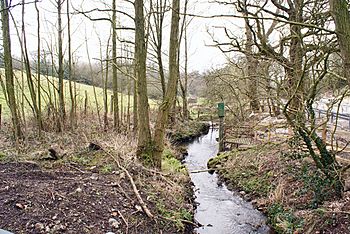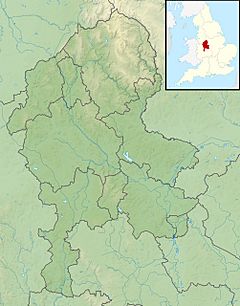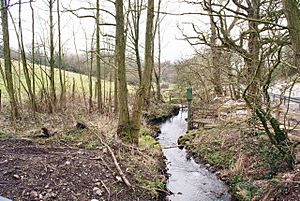Ford Green Brook facts for kids
Quick facts for kids Ford Green Brook |
|
|---|---|

Ford Green Brook near Brindley Ford
|
|
|
Ford Green brook within Staffordshire
|
|
| Country | England |
| Counties | Staffordshire |
| Physical characteristics | |
| Main source | Mow Cop |
| River mouth | Milton, Staffordshire 53°02′39″N 2°08′43″W / 53.0442°N 2.1453°W |
| Length | 10 km (6.2 mi) |
| Basin features | |
| Basin size | 15 km2 (5.8 sq mi) |
| Progression : Ford Green Brook—Trent—Humber | |
The Ford Green Brook is a small river that flows through Staffordshire in England. It runs through the outer parts of Stoke-on-Trent. This brook is special because it's the very first stream to join the River Trent. The Ford Green Brook is about 10 miles (16 kilometers) long.
Contents
Where Does Ford Green Brook Flow?
The Ford Green Brook starts near a village called Mow Cop. It begins on the side of a rocky hill where the village is located. From there, the brook flows southeast through a narrow valley.
Journey Through Towns and Cities
The brook passes through Brindley Ford before entering the larger area of Stoke-on-Trent. It flows past the old Chatterley Whitfield coal mine, where it used to run underground. Then, it goes between the areas of Bradeley and Norton-in-the-moors, reaching Ford Green.
The brook continues its journey to the east of Smallthorne and Sneyd Green. Here, it flows under the Caldon Canal. Finally, the Ford Green Brook joins the River Trent near Milton, Staffordshire.
What is a River Catchment Area?
A river's catchment area is all the land where rainwater collects and drains into that river. The Ford Green Brook's catchment area is about 15 square kilometers (5.8 square miles). This area is located between the catchment of the River Trent to the north and east, and the Scotia Brook to the south and west.
In the past, the Ford Green valley was a busy place for heavy industries. Coal mines like Chatterley-Whitfield supplied coal to the Ford Green ironworks. Today, many parks and wildlife areas have replaced these old industrial sites. They are connected by a special cycle route. These places include the Chatterley-Whitfield heritage park, the Whitfield Valley nature reserve, and Holden Lane pools.
The Old Name: Banky Brook
Banky Brook was the traditional name for this stream as it flowed through Stoke. It was a very popular spot for local children to play in the past. You can still find a reminder of this name today. A street in the nearby village of Bradeley is called Banky Brook Close.
When the Brook Flooded
In August 1987, there was a lot of rain. The Ford Green Brook overflowed its banks. This caused a flood at Ford Green Hall, which is a 16th-century historic house museum. The water inside the house was very deep, reaching about 4 to 5 feet (1.2 to 1.5 meters). Antique furniture was seen floating around the lower rooms!
The damage from this flood was so bad that the hall had to close for two years. During this time, it was repaired and made new again.
Wildlife Around the Brook
Even though the Ford Green Brook has been rated as having "poor ecological quality," it's still home to many plants and animals. Ecological quality is a way to measure how healthy a river's environment is. The scale goes from high, good, and moderate, down to poor and bad.
Despite this rating, you can still find interesting creatures along the brook. These include water voles, which are small rodents that live near water. You might also spot grass snakes and different types of dragonflies.
A Special Place for Swallows
There's a special area called the Ford Green reed bed. It's located at the lower end of the Whitfield Valley nature reserve. This spot has been named a Site of Special Scientific Interest. This means it's a very important place for nature.
Why is it so special? Because huge groups of swallows, known as Hirundo rustica, gather here. They stop at this reed bed before they fly south for the winter. It's like a big meeting point before their long journey!



